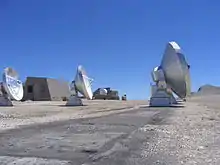Plateau de Bure Interferometer
The Plateau de Bure Interferometer (PdBI) was a six-antenna interferometer on the Pic de Bure (2550 m) in the French Alps, operated by the Institut de radioastronomie millimétrique. In 2014, it has been replaced by the Northern Extended Millimeter Array.[1] It was specifically designed for millimetre-wave observations and specialises in studies of line emission from molecular gas and radio continuum of cold dust.[2]
 Several of the interferometer's antennas, with one of the rails for antenna displacement in the foreground. | |
| Alternative names | PdBI |
|---|---|
| Part of | Institut de radioastronomie millimétrique |
| Location(s) | Grenoble, canton of Grenoble-5, arrondissement of Grenoble, Isère, Auvergne-Rhône-Alpes, Metropolitan France, France |
| Coordinates | 44°38′02″N 5°54′29″E |
| Organization | Institut de radioastronomie millimétrique |
| Altitude | 2,550 m (8,370 ft) |
| Built | 1988– |
| Telescope style | radio interferometer |
| Replaced by | Northern Extended Millimeter Array |
| Website | www |
 Location of Plateau de Bure Interferometer | |
The interferometer consisted of six antennas with a diameter of 15 m each. These antennas could be placed in a T-shaped pattern, with north–south track of 368 m and an east–west track of 768 m. There were 32 stations along these tracks where the antennas can be positioned. Observing bands are at 3, 2, 1.8 and 0.8 mm.[3] At an observing wavelength of 3 mm (100 GHz frequency) each of these telescopes could resolve two objects 45 arcseconds apart from each other on the sky. In an interferometer, these 45″ are actually the size of the field of view. So an interferometer like this one images, at very high resolution (better than 1″), structures smaller than 45″.[4]
Aerial tramway
The observatory was serviced by an aerial tramway.
See also
- List of radio telescopes
- List of astronomical observatories
- CARMA another millimetre-wave array operated by a consortium including Caltech, University of California Berkeley, University of Illinois, University of Maryland and University of Chicago.
- Atacama Large Millimeter Array, a large (sub)millimetre-wave array.
- Northern Extended Millimeter Array
References
- "First step for NOEMA: MPG President, INSU Director and German Ambassadress inaugurate 1st antenna!". www.iram-institute.org. Retrieved 2020-11-16.
- "About the IRAM interferometer".
- "Description of the Plateau de Bure Interferometer". 10 March 2013. Archived from the original on 5 December 2008.
- "Spatial Resolution of the Plateau de Bure Interferometer". 10 March 2013. Archived from the original on 5 December 2008.
- https://www.theguardian.com/world/1999/jul/01/1
- https://www.theguardian.com/world/1999/jul/02/jonhenley
- http://news.bbc.co.uk/1/hi/world/europe/383432.stm
- John Lichfield (2 July 1999). "Alpine cable car disaster kills 20". The Independent.